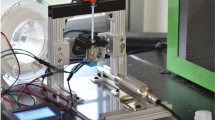Abstract
Anisotropic mechanical properties related to build orientation is a characteristic of parts fabricated with 3D printing technologies. In the development of new materials for 3D printing processes, understanding the effects of 3D printer build orientation and raster pattern on physical property and failure mode differences is extremely important. While there is currently no standard for the evaluation of build orientation-based mechanical performance, such analysis has typically been achieved through the fabrication and scrutiny of tensile and other test coupons which were printed in different build orientations. In some cases, printing specimens in the ZXY (or vertical) build orientation can be difficult due to the capability of a given 3D printer platform. There are also multiple tensile test specimen geometries specified in the ASTM D638 standard for the tensile testing of polymer materials and understanding which specimen geometry works best for 3D printing is not currently well understood. The work presented here explores the effect of tensile test specimen geometry on the anisotropy of mechanical properties related to the build orientation of tensile test specimens. The test coupons were fabricated using a material extrusion 3D printing platform based on fused deposition modeling technology using a grade of acrylonitrile butadiene styrene not typically used in 3D printing in order to simulate the testing of a new material. The effects of raster pattern and the geometric dependence of mechanical property anisotropy were explored, and validation of the use of “faux vertical” specimens in lieu of ZXY-printed specimens was demonstrated. Finally, scanning electron microscopy was used to perform fractography on the various versions of the printed tensile test specimens in order to determine the effect of raster pattern on failure mode.














Similar content being viewed by others
References
C.W. Hull, Apparatus for production of three-dimensional objects by stereolithography. U.S. Patent No. 4,575,330. 11 March 1986
ASTM F2924-14, Standard specification for additive manufacturing titanium-6 aluminum-4 vanadium with powder bed fusion (ASTM International, West Conshohocken, 2014)
ASTM F3001-14, Standard Specification for Additive Manufacturing Titanium-6 Aluminum-4 Vanadium ELI (Extra Low Interstitial) with Powder Bed Fusion (ASTM International, West Conshohocken, 2014)
ASTM F3049-14, Standard Guide for Characterizing Properties of Metal Powders Used for Additive Manufacturing Processes (ASTM International, West Conshohocken, 2014)
ASTM F3055-14a, Standard Specification for Additive Manufacturing Nickel Alloy (UNS N07718) with Powder Bed Fusion (ASTM International, West Conshohocken, 2014)
ASTM F3056-14e1, Standard Specification for Additive Manufacturing Nickel Alloy (UNS N06625) with Powder Bed Fusion (ASTM International, West Conshohocken, 2014)
ASTM F3122-14, Standard Guide for Evaluating Mechanical Properties of Metal Materials Made via Additive Manufacturing Processes (ASTM International, West Conshohocken, 2014)
ASTM F2792-12a, Standard Terminology for Additive Manufacturing Technologies (ASTM International, West Conshohocken, 2013)
ASTM 52921:13, Standard Terminology for Additive Manufacturing—Coordinate Systems and Test Methodologies (ISO/ASTM International, West Conshohocken, 2013)
ASTM F3091M-14, Standard Specification for Powder Bed Fusion of Plastic Materials (ASTM International, West Conshohocken, 2014)
A.R. Torrado, C.M. Shemelya, J.D. English, Y. Lin, R.B. Wicker, D.A. Roberson, Characterizing the effect of additives to ABS on the mechanical property anisotropy of specimens fabricated by material extrusion 3D printing. Addit. Manuf. 6, 16–29 (2015). doi:10.1016/j.addma.2015.02.001
A.R. Torrado Perez, D.A. Roberson, R.B. Wicker, Fracture surface analysis of 3D-printed tensile specimens of novel ABS-based materials. J. Fail. Anal. Prev. 14(3), 343–353 (2014)
S. Shaffer, K. Yang, J. Vargas, M.A. Di Prima, W. Voit, On reducing anisotropy in 3D printed polymers via ionizing radiation. Polymer (2014). doi:10.1016/j.polymer.2014.07.054
A. Bellini, S. Güçeri, Mechanical characterization of parts fabricated using fused deposition modeling. Rapid Prototyp. J. 9, 252–264 (2003). doi:10.1108/13552540310489631
O.S. Es-Said, J. Foyos, R. Noorani, M. Mendelson, R. Marloth, B.A. Pregger, Effect of layer orientation on mechanical properties of rapid prototyped samples. Mater. Manuf. Process. 15, 107–122 (2000). doi:10.1080/10426910008912976
R. Hague, S. Mansour, N. Saleh, R. Harris, Materials analysis of stereolithography resins for use in rapid manufacturing. J. Mater. Sci. 39, 2457–2464 (2004). doi:10.1023/B:JMSC.0000020010.73768.4a
V. Vega, J. Clements, T. Lam, A. Abad, B. Fritz, N. Ula et al., The effect of layer orientation on the mechanical properties and microstructure of a polymer. J. Mater. Eng. Perform. 20, 978–988 (2011). doi:10.1007/s11665-010-9740-z
A. Bagsik, V. Schoeppner, E. Klemp, in 4th International Scientific Conference on Polymeric Materials (2010)
R. Hague, S. Mansour, N. Saleh, Material and design considerations for rapid manufacturing. Int. J. Prod. Res. 42, 4691–4708 (2004). doi:10.1080/00207840410001733940
B. Caulfield, P.E. McHugh, S. Lohfeld, Dependence of mechanical properties of polyamide components on build parameters in the SLS process. J. Mater. Process. Technol. 182(1), 477–488 (2007)
ASTM D638, Test Method for Tensile Properties of Plastics (ASTM International, West Conshohocken, 2010)
S.-H. Ahn, M. Montero, D. Odell, S. Roundy, P.K. Wright, Anisotropic material properties of fused deposition modeling ABS. Rapid Prototyp. J. 8, 248–257 (2002). doi:10.1108/13552540210441166
A.R. Torrado Perez, Defeating Anisotropy in Material Extrusion 3D Printing via Materials Development, Ph.D. Dissertation, Materials Science and Engineering, The University of Texas at El Paso, El Paso, 2015
D.A. Roberson, A.R. TorradoPerez, C.M. Shemelya, A. Rivera, E. MacDonald, R.B. Wicker, Comparison of stress concentrator fabrication for 3D printed polymeric izod impact test specimens. Addit. Manuf. 7, 1–11 (2015). doi:10.1016/j.addma.2015.05.002
Acknowledgments
The work presented here was performed in the W.M. Keck Center for 3D Innovation (Keck Center) and the Department of Metallurgical, Materials and Biomedical Engineering (MMBME) at The University of Texas at El Paso (UTEP). The authors are grateful for the internal support from the Keck Center and use of the scanning electron microscopy complex in the MMBME department. Funding for this work was provided by the AFOSR through the Young Investigator Program (YIP) under Grant Number FA9550-14-1-0260.
Author information
Authors and Affiliations
Corresponding author
Rights and permissions
About this article
Cite this article
Torrado, A.R., Roberson, D.A. Failure Analysis and Anisotropy Evaluation of 3D-Printed Tensile Test Specimens of Different Geometries and Print Raster Patterns. J Fail. Anal. and Preven. 16, 154–164 (2016). https://doi.org/10.1007/s11668-016-0067-4
Received:
Published:
Issue Date:
DOI: https://doi.org/10.1007/s11668-016-0067-4




